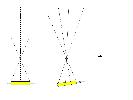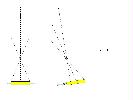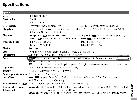(In reply to)
Messages on Anaglyphs group
Post on Anaglyphs group
Viewed
 (26K)
(26K) (27K)
(27K) (25K)
(25K) (300K)
(300K)Hi Mark!
For first: the Fuji has really 6,3 mm focal lenght, but regarding the chip size, it is equivalent to a 35 mm focal lenght on film 36x42mm.
35 mm focal lenght has a 54 degrees of hotizontal FOV.
The Fuji, in 3D mode uses ONLY 49 degrees of horizontal FOV, from the chip ( 5 degrees of difference). For this in 3D mode the used FOV is equivalent to a 39 mm focal on film 36x24mm.
See the attachment, specification.
The toe-in is equal to the convergence, no other type of convergence exists.
What are you doing, when adjust the parallax control???
For my idea you are moving the right image, selecting different part of the recorded image on the chip, what is 54 degree in horizontal, but you select en see every time only a part of 49 degrees.
If you see the attachment, you can see what happens on the chip in the middle, far and near vision.
So: shifting to left and right on the right chip is equal to change the convergence too. Conclusion: adjusting the parallax on the Fuji is equal to shifting and adjusting the convergence too...
I'm not good in 3D programs, but I easy understand that is difficult to use the fuji 3D images.....perhaps, if the 3D camera plugin in the software, has some setup possibilities, the job will be easer?!
Hope everything is clear...
Imre
From: Imre dr.Zsolnai-Nagy <imrezsolnainagy(-at-)
To: anaglyphs(-at-)yahoogrou
Sent: Sat, June 26, 2010 5:05:11 AM
Subject: Re: [Anaglyphs] Some closeup with converged cameras with SDM 003 last
It is very difficult with my bad English explain all what I want, but I try it.
The camera lenses are centered, the eye lens system is decentered.
See image decentered.jpg
In other words: when our eyes see parallel we have a certain convergence. So the convergence is built-in in your eyes.
See image: decentered01. jpg
The parallel cameras dont have this "built-in" convergence and for this reason we have problems at the edges on our anaglyphs.
If you see:absent.jpg, you will understand that we have constantly need a little of FOV and film. This problem was resolved by the Realist, shifting the film. But I think this isnt enough, because is absent the real convergence ( the "built-in" ).
The big goal made by Fuji W1 is: the Fuji made the real "built-in" convergence and made too the "film-shift" too.
Remember? The 2D mode has 35 mm focal at the Fuji, but the 3D mode is only 39 mm. What it means?
It means that the
Fuji has a possibility to shift the film in a certain limits.
Fuji.jpg: see the limit of the fil shif on the left lens, what isnt converged,
On the right lens the Fuji has the "built in" convergence too, and the same possibility of the film shift.
I agree that the convergence isnt the best way because this produces keystone effect, but since the convergence is about 2 degrees, the solution is acceptable.
One of my friends (Antonello Satta) made the theoretical ideal stereo camera. It is based on "shift lenses".
See: ideal stereocamera. jpg
So the conclusion: if we have 2 cameras the suggestion is this:
Use a convergence of 1-2 degrees ( enough on only one camera ) and use a wide angle lenses, but at the final crop use less image size than the original. ( exactly what done the Fuji )
Imre
Imre,
Nice result, but what was the purpose for converging the cameras? To get closer to the subject? To reduce deviation?
Brian
My Flickr page: http://www.flickr. com/photos/ ur4chun8/ Click on a thumbnail pic, then Click on "+ ALL SIZES" (for larger view) My photos according to "Interestingness" http://fiveprime. org/hivemind/ Tags/Brian, Wallace,3d
From: imrezsolnainagy(-at-) gmail.com
Date: Fri, 25 Jun 2010 20:02:54 +0200
Subject: [Anaglyphs] Some closeup with converged cameras with SDM 003 last
The cameras I converged 2 degrees on 65 mm base...
Imre
--
http://imre3d. axo.hu
--
http://www.conversi on3d.freeweb. hu
http://imre3d. axo.hu
--
http://www.conversi
http://imre3d.